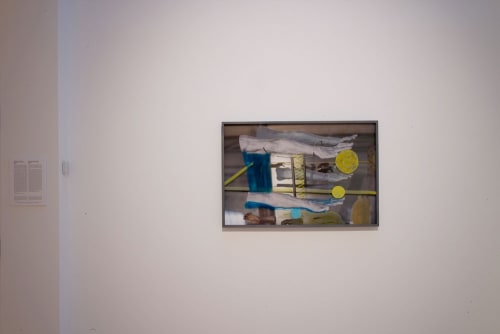“With Rodin Reworked, the paint that Adad Hannah applies over photographs of Auguste Rodin’s sculptures comes into view like some kind of alien matter, interrupting the material circumstances of both sculpture and photography. The paint is viscous and amorphous, but it also has an energetic force. The result is that Hannah’s lively gestures of pigment appear to interact with Rodin’s gesturing bodies.
Hannah has been working with Rodin over an extended period of time. What does it mean for a contemporary artist to “work with” a long-deceased historical artist? There is certainly an element of paying homage to the earlier artist, but this sustained relationship goes beyond that to become a genuine conversation across time. In Rodin’s work, Hannah has found a generative source (or sounding board) for his own, twenty-first century interrogation of images and bodies. More precisely, Hannah’s repeated encounters with Rodin allow him to explore a tension between still and moving images, and simultaneously, a tension between still and moving bodies.
In some of Hannah’s past projects, the engagement with Rodin resulted in outright re-makes of specific artworks. The Burghers of Seoul, 2006 (based on the famous multi-figure monument, The Burghers of Calais, 1889) is a prime example of that impulse. Rodin’s sculpture was disturbing when it first appeared because it so clearly subverted the monumental tradition: the six male figures are not grouped symmetrically or settled into conventional heroic poses, but instead are represented mid-movement – each figure striding, swaying, bending or hesitating. In Hannah’s moving-image version, the uniformed men replicating the Rodin burghers’ bodily states are motorcyle couriers, citizens of Seoul who spend their days travelling through the city. In the artwork, as they awkwardly hold their designated poses, they become living monuments to twenty-first century urban movement and communication.
In this recent body of work, as with some of the earlier Rodin-oriented projects, it is the relationship between sculpture and photography that comes into focus, even while the expressivity of moving/gesturing bodies is still key. The art historian Rosalind Krauss has written that “the surface of the body, that boundary between what we think of as internal and private, and what we acknowledge as external and public, is the locus of meaning for Rodin’s sculpture.” This value accorded to the surface of the body rings true for Hannah, but in the Rodin Reworked artworks it is also the surface of photographs which is at stake. It’s useful to know that Rodin himself developed a habit of drawing directly onto photographs of his works-in-progress or finished works. But Hannah is actually painting on the glass protecting the image, and not on the photographs themselves, and what this does is complicate the very question of surface. Hannah’s painterly marks lie neither on the surface of the sculptures nor on the surface of the photographs, and instead the paint seems to hover mid-air, and between media. These mysteriously detached marks have life-like agency, that energizes and re-activates both sculptures and photographs, giving new life to those remnants of the past.”
- Johanne Sloan Department of Art History, Concordia University
Figurative sculpture, especially the work of Auguste Rodin, has always been a contradictory practice that turns the human body into an inanimate lump of material while simultaneously animating the plaster, stone, or bronze it is fashioned out of. Human life is distilled into a thing, and then that thing - through its interactions with people - is given life.
Adad Hannah’s Rodin Reworked is a new body of works produced in collaboration with the Musée Rodin, Paris. This series builds upon his interest in the French sculptor Auguste Rodin’s (1840-1917) oeuvre in relation to the interplay between sculpture and the human body, and the ways in which we observe and interact with art.
Hannah has explored these ideas in conversation with Rodin’s art for more than a decade with projects such as Age of Bronze (2004) shot at the National Gallery of Canada, Burghers of Seoul (2006) produced in South Korea, Les Bourgeois de Calais: Crated and Displaced (2010) made in Calais, Unwrapping Rodin (2010) which was included in a touring show of Rodin’s work organized by the Montreal Museum of Fine Arts and the Musée Rodin, Paris, and The Burghers of Vancouver (2015), a collaboration with Quebeçois filmmaker Denys Arcand.
Rodin was an avid collector of photographs, often drawing and painting on top of images of his own work. These photographs with pen, pencil, or gouache on them were used as ways to reimagine a work, to test an idea before rendering it in plaster in preparation for bronze or marble. Rodin also used bright pigments in his sketches, though his final sculptures were almost always monochromatic.
Just as Rodin used other people’s photographs to imagine other ways his sculptures could be viewed, Adad Hannah uses painted layers suspended in front of photographs he took of Rodin’s plasters. By overlaying still images with painted glass sheets Hannah emphasizes how light and colour alter our perception of sculpture while exploring the distinctions between the symbolic presence of a sculpture and the organic physicality of the human body. These works also focus on the connection between the past and the present - initiating a conversation between Rodin’s 19th century sculptures and current photographic and mark-making practices.
Having studied printmaking and painting early in his art training, this new body of work brings together Hannah’s earliest artmaking practices with the performative photographic and video works he has spent the last fifteen years producing around the world. The painted glass floats above the photograph, creating an interplay of colour, reflection, translucency, and opacity. This interplay obscures, highlights, and activates Rodin’s frozen bodies as the viewer’s own body moves around the artwork. Johanne Sloan, Concordia University

